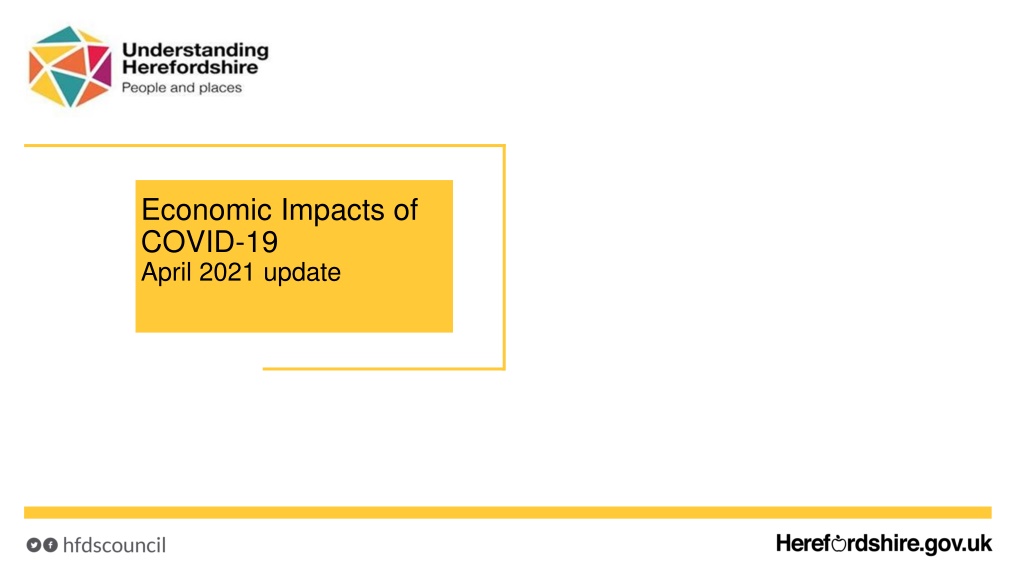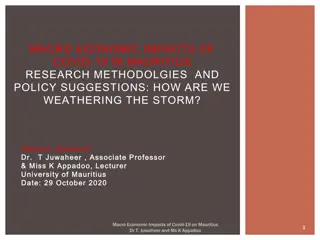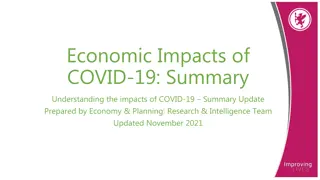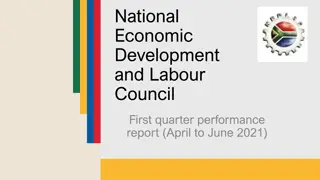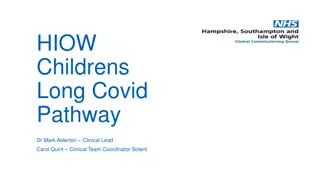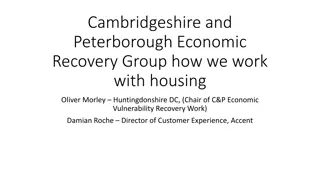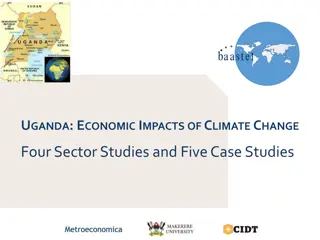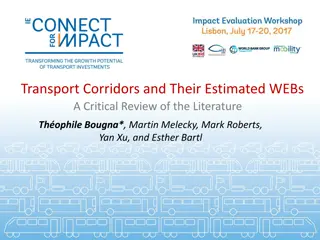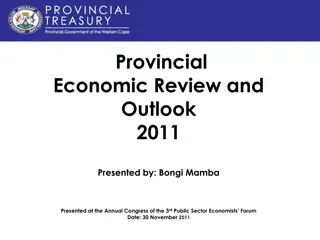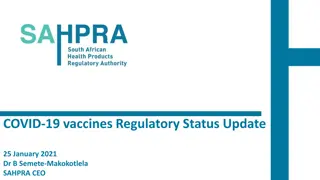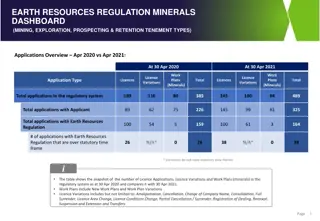Economic Impacts of COVID-19: April 2021 Update
The monthly briefing on the economic impacts of COVID-19 provides the latest insights, focusing on Herefordshire's economy. Despite the easing of lockdown restrictions, data suggests a mixed impact, with some sectors faring better than others. National and international research indicates potential long-term socio-economic changes and widening inequalities, posing challenges for vulnerable communities and certain industries. Concerns also arise regarding the future of jobs post-government support schemes and implications for public spending.
Download Presentation

Please find below an Image/Link to download the presentation.
The content on the website is provided AS IS for your information and personal use only. It may not be sold, licensed, or shared on other websites without obtaining consent from the author. Download presentation by click this link. If you encounter any issues during the download, it is possible that the publisher has removed the file from their server.
E N D
Presentation Transcript
Economic Impacts of COVID-19 April 2021 update
About this briefing This monthly publication brings together the latest understanding about the economic impacts of coronavirus, which is changing all the time as the situation itself changes and as new research emerges. April s edition has been shortened to focus on new data and intelligence released since last month. March s more comprehensive edition is still available for reference on the Understanding Herefordshire website. Contents 1. Key messages: what s new this month, including links to the relevant detail within the document 2. Local context: factors to be aware of about Herefordshire s economy 3. Labour and housing markets and business activity: including job postings, newly released housing affordability and Google mobility data 4. Unemployment and support for jobs: including this month s claimant count and latest data on furlough and self-employment income support scheme 5. Support for Herefordshire businesses: including grants and loans paid out 6. National news roundup: recent, significant national and international research If you need help to understand this document, or would like it in another format or language, please contact us on 01432 261944 or e-mail researchteam@herefordshire.gov.uk
Key messages: whats new this month April saw the start of national lockdown restrictions easing, hopefully paving the way for a recovery in economic activity later this year although globally the pandemic is far from over. With widespread re-opening in England only starting a week ago, it s too early to see the impact in the data. This month s Latest data suggests that Herefordshire s economy didn t suffer to the same extent in this lockdown as during the first: 4,800 people were claiming unemployment-related benefits in March 2021. Although this is around 400 more than in January, it is still around 200 lower than the peak of May 2020. However, there are clear variations within the county, with those wards that had higher levels of claimants before the pandemic generally being harder hit. ONS s latest BICS survey: higher number of businesses trading than English average, fewer concerns about turnover or short-term cash reserves and lower than average numbers on furlough Job postings have held up well, and population movements didn t reduce as much as last spring and are already showing an upturn following the 12 April easing National picture is similar, with some indications of a strong overall recovery; although lasting disproportionate impacts are likely Last month s Businesses adapted well to restrictions and didn t see the same reductions in activity as they did during the first lockdown. UK economy as a whole appears to have suffered less than a year ago, and even grew slightly in February. There are also some encouraging signs nationally that the economy will recover strongly once lockdown restrictions are lifted, and that scarring will be less than anticipated earlier in the crisis. National and international research is highlighting how some socio-economic changes are likely to be permanent and this has significant implications for disadvantaged communities and certain businesses, for example, in the hospitality and retail sectors. Evidence continues to emerge of the widening of existing health and socio-economic inequalities: Economically, young people (see slides 32 and 42) and those in already low-paid occupations have been harder hit than others. This is potentially concerning for Herefordshire which historically has below lower than average wages and high numbers employed in low-paid occupations. Uncertainty also remains over what will happen to jobs once government support schemes eventually end and the impact on future public spending of the levels of government debt accrued during the crisis. A major new report by the British Academy discusses these widening inequalities but also highlights the vital importance of community-led responses that draw upon local knowledge and resources, suggesting that those communities that entered the pandemic with such infrastructure have been best placed to respond. Concerns for the high street: PWC has highlighted an alarming number of chain store closures in the West Midlands with more expected in the coming months, while KPMG warn that nationally high streets could lose 20-40% of their retail offerings as a result of the accelerated shift to online commerce.
Some factors to be aware of in Herefordshire In Herefordshire, the key issues for the economy over the coming months and years are likely to include: Our high-reliance on businesses and jobs that have been hardest and longest hit by restrictions: roughly 9,500 jobs in around 1,100 enterprises in vulnerable sectors (hospitality, food, arts, entertainment, travel). A high proportion of our businesses are micro and small enterprises which is a mixed blessing these businesses can be more agile and innovative but are also more vulnerable to cash flow problems and/or the loss of a key market. A seasonal workforce: reliance on migrant workers who may not be willing or able to travel this year. Data to test this hypothesis should become available once the current farm survey is completed. Economic scarring which may increase the number of long-term unemployed and workless households. The impact of the disruption to education and the labour market on the ability of our young people to find work and pursue rewarding and well-paid careers. Sections of the economy may undergo permanent change, for example in the acceleration of consumer preference for online shopping, and as a consequence, areas where future vacancies are generated may require skills, qualifications and experience that those who have lost their jobs do not have within this skills gap already disadvantaged groups and low-income workers are likely to be disproportionately affected.
Herefordshires economy: key facts In employment Self-employed Student Looking after family/home Long-term sick Retired Other 93,300 23,200 5,100 3,000 5,500 5,100 2,500 These numbers relate to the working age population (aged 16-64) Claimant count 4,800 Workless households 7,100 Total enterprises Micro (0-9) Small (10-49) Medium (50-249) Large (250+) 10,350 9,320 860 140 Data Source: ONS/NOMIS Herefordshire Labour Market Profile Date last updated: 20 April 2021 Frequency of update: monthly 30
1. Herefordshires labour and housing markets and business activity Businesses and jobs in high risk sectors Job postings Housing affordability Mortgage and landlord possessions ONS business impacts of coronavirus survey (BICS) Effects of lockdown on population movement
Businesses and jobs in high risk sectors in Herefordshire Around 9,500 jobs in Herefordshire are in accommodation and food services or arts, entertainment, recreation & other services sectors, which nationally are considered to be at most immediate risk from lockdown restrictions. 6% of enterprises in Herefordshire are in arts, entertainment, recreation & other services and 6% in accommodation and food services : sectors that nationally are considered to be at most immediate risk from the lockdown measures taken to contain the spread of COVID-19. This equates to around 1,100 local enterprises. 90% of enterprises and 86% of local units comprise micro business (0-9 employees) that are also more vulnerable to economic turbulence and accompanying cash flow problems. Using an Exposure Index developed by labour market analytics company EMSI, there are around 5,400 jobs in Herefordshire in occupations with an EI 70 which indicates a high exposure to the disruptions caused by the coronavirus pandemic and the resulting lockdown given their dependence of a range of factors, including: The need for physical proximity in jobs. Take up of furloughing scheme. Dependence on affected supply chains. Dependence on affected market demand. Proximity of key worker functions which may enhance demand and/or competition. Need to know: An Enterprise is the smallest combination of legal units which has a certain degree of autonomy within an Enterprise Group.
Job postings in Herefordshire In the period between January 2020 and March 2021 there were 26,272 unique job postings in Herefordshire. So far, job postings have held up well during the pandemic, which in combination with the claimant count data appears to suggest that Herefordshire s economy has been quite resilient to the economic turbulence of the past twelve months. Need to know: A unique job posting is one that has been de-duplicated as postings can appear on multiple websites, multiple times. Data include voluntary, internships, side jobs and freelance. Top posted occupations January 2020 to March 2021 Trend in unique job postings 2016-2021 Data source: EMSI Date last updated: April 2021 Frequency of update: monthly
Housing affordability in Herefordshire Unlike the 2008/09 economic downturn, nationally average house prices increased while the economy shrank. However, ONS report that the gap between the most and least affordable local authorities continued to decrease in 2020. In 2020, the ratio of lower quartile house price to workplace- based lower quartile earnings in Herefordshire (8.79) was among the highest in the West Midlands (7th highest out of 30) and was significantly higher than the average for the West Midlands and England as a whole (7.15 and 6.8 respectively). Historically, the average earnings of those working in the county have been lower than regionally and nationally. Herefordshire is consequently vulnerable to house price increases driven by demand from those with out-of-county wealthy or incomes. The latest data show Herefordshire is still among the worst in the region for housing affordability and significantly worse than across England as a whole. Recently, the Joseph Rowntree Foundation warned that the extension of the Stamp Duty Holiday and the 95% mortgage guarantee scheme announced in the 2021 Budget are, in the short term, likely to compound the UK housing crisis by driving up house prices further. *Unitaries, counties and metropolitan boroughs Data source: ONS Date last updated: April 2021 Frequency: annual Need to know: Previously we have reported using residence-based earnings, however the preferred measure used by ONS to report national trends is workplace-based earnings so, although both measures are valid, we have switched to this measure.
Mortgage and landlord possessions in Herefordshire Reflecting the position nationally, as at quarter 2 2020 (the latest data available) the economic damage inflicted by the pandemic had not so far manifest in any local increase in mortgage and landlord possessions in Herefordshire. This is likely due to: Government action to encourage lenders to grant a mortgage holiday period and to protect social and private renters and landlords by stipulating that no renter in either social or private accommodation was allowed to start proceedings to evict tenants experiencing financial difficulties due to coronavirus. Court closures during lockdown 1 meant cases currently in the system could not be heard, creating a backlog that has yet to be cleared. Source: LG Inform Date last updated: March 2021 (Q3 2020/21) Frequency: quarterly
ONS business impacts survey - Herefordshire Key points: According to latest data from the Business Impacts of Coronavirus Survey (BICS) Herefordshire has: higher than average numbers of businesses currently trading (83%) lower than average numbers of full or partial furlough leave (16%) lower numbers reporting a fall in turnover (35%), lower numbers reporting problems with their cash reserves for the next 3 months (48%) Need to know ! Experimental estimates based on single site weighted results of the voluntary fortnightly Business Impact of Coronavirus. Likely to be based on a small numbers of responses. Source: ONS Date last updated: 1 March 2021 Frequency of update: monthly HC data lead: Intelligence Unit
Effects of lockdown on population movement This chart shows average visits to different categories of places, using location data of Google users, compared to the beginning of 2020. After an initial drop following the 4 Jan lockdown, visits to most categories (except residential) increased slowly during the latest lockdown although still remain below the pre-pandemic baseline (except parks, which has a seasonal pattern). There has been a clear upturn in movement since the end of March, particularly to retail and recreation and parks . Neither are unsurprising, given the ending of the stay at home rule and reintroduction of rule of 6 on 29 March in time for the Easter holiday weekend, and lifting of restrictions on non-essential retail and outdoor eating/drinking on 12 April. Changing visits in Herefordshire to Third national lockdown (5 Jan) Parks First full national lockdown (23 Mar) Residential Grocery & pharmacy Retail & recreation Workplaces Stations English lockdown 2.0 (5 Nov-2 Dec) English social restrictions ease on 29 Mar & 12 Apr Where can I find out more? This chart is updated daily on the Data Orchard website, using data published by Google. The baseline is the median value, for the corresponding day of the week, during the five weeks 3 Jan 6 Feb 2020. Note that the data is based on movements of those who have opted to turn on location history in their Google accounts on their mobile devices.
2: Unemployment and support for jobs Claimant count: all ages Claimant count as a proportion of all residents aged 16 to 64 Claimant count rate by Herefordshire Ward Claimant count: 18-24s Model-based unemployment rate: trend Furloughed employees: trend Variation in furlough rates across UK industrial sectors National variation in UK furlough rates by employer size Claims made under the Self-employment Income Support Scheme (SEISS) third grant Self-employment income support scheme - take up rate by industrial sector
Claimant count: all ages Key points: 4,800 people aged 16+ claiming unemployment related benefits* in March. Monthly comparisons are difficult as previous data is often revised, but numbers have been at a relatively stable level since May 2020 (around 4,400 to 5,000) with a modest drop last autumn through to January (4,435), increasing again as the effects of the third lockdown were felt. More than double the number in March 2020 (+127%); disproportionate increase compared to England (+117%) but started from a much lower base Around 1,700 more claimants than peak due to 2008-09 recession What this doesn t tell us: Claimant count is NOT a full measure of unemployment, but it is the most timely indicator We don t know which sectors jobs have been lost from Some jobs will have been protected by government support schemes ! Need to know ! * Includes people claiming Jobseeker's Allowance plus those claiming Universal Credit who are required to seek and be available for work. Source: ONS, via NOMIS Date last updated: 20 April 2021 Frequency of update: monthly HC data lead: Intelligence Unit
Claimant count as a proportion of all residents aged 16 to 64 The Herefordshire claimant count as a proportion of the working age population has increased but started from a lower base and remains significantly lower than in the West Midlands and England as a whole. Need to know: The residence-based proportion shown in this chart is the official measure below national/regional level. It is available for local authorities, constituencies, travel to work areas, regions and countries and it expresses the number of claimants as a percentage of the population aged 16-64, sourced from the mid-year population estimates. At national/regional level the official measure is the workplace-based rate, but this measure can be used to compare national/regional areas with smaller areas (e.g. local authorities) to ensure comparison of like with like. Although the claimant count rate is one official measure of unemployment, a more accurate measure of the unemployment rate is derived from the Labour Force Survey. For more information see NOMIS or the Economics Help website. Data source: ONS via NOMIS. Last updated: 20 April 2021 (March). Frequency of update: monthly
Claimant count rate by ward Key points: In March 2021, the highest claimant count rates as a proportion of residents aged 16-64 were in Hinton & Hunderton, Widemarsh and Newton Farm Wards, which also had the highest numbers of claimants (235, 175 and 200 respectively). These were followed by other parts of Hereford, Leominster, Ross and Bromyard. Ross North, Widemarsh and Hinton & Hunderton Wards have seen the largest increases in claimant count rate from March 2020. The claimant count rate for the county as a whole in March was 4.3%. Need to know: The claimant count rate should not be confused with the official unemployment rate which is based on different data and is not available at Ward level. All data are rounded to the nearest 5 Note that due to the small population sizes a relatively small change in the number of claimants can have a significant impact on the rate. Data source: ONS, via NOMIS Date last updated: 20 April 2021 Frequency of update: monthly HC data lead: Intelligence Unit
Claimant count: 18-24s Key points: 895 people aged 18-24 claiming unemployment related benefits* in March. Monthly comparisons are difficult as previous data is often revised, but numbers have fallen since peaking at 1,000 in July. Still double the number in March 2020 (+116%), but appears to have recovered slightly more than in England (120%) although note it started from a much lower base. What this doesn t tell us: Claimant count is NOT a full measure of unemployment, but is the most timely indicator We don t know which sectors jobs have been lost from Some jobs will have been protected by government support schemes ! Need to know ! * Includes people claiming Jobseeker's Allowance plus those claiming Universal Credit who are required to seek and be available for work. Data source: ONS, via NOMIS Date last updated: 20 April 2021 Frequency of update: monthly HC data lead: Intelligence Unit
Model-based unemployment rate: trend Key points: In the period January to December 2020 the unemployment rate in Herefordshire was 3% (CI+-1.4), compared to 4.6% (CI+-0.2) in England as a whole and 5.3 (CI+-0.5) across the West Midlands region. Herefordshire s unemployment rate is thus not significantly different from England but is significantly lower than in the West Midlands region. This shows the official annual unemployment rate which IS NOT the same as the claimant count rate (see slide 15). What this doesn t tell us: No further breakdown is available below all- age county rate. Data source: ONS, via NOMIS Date last updated: 21 April 2021 Frequency of update: quarterly HC data lead: Intelligence Unit ! Need to know ! Model-based estimates are produced for local authority areas. Estimates of unemployment for nations and regions are not model-based and have been taken directly from the Annual Population Survey dataset. For more information on the difference between the unemployment and claimant count rates see this article.
Furloughed employees: trend Key points As at 31 January 2021, the take up rate for the furlough scheme in Herefordshire (15%) was the same as both nationally and regionally. At that point, furloughing of staff across all sectors had, in line with the national trend, increased significantly from the previous month but was still well below the 30% seen in June. Provisional figures as at the end of February 2021 suggest the take-up rate had fallen very slightly to 14% in Herefordshire: again, similar to regionally (14%) and nationally (15%) What this doesn t tell us What we do not know is how many of these jobs will still exist when the scheme ends. Data Source: HMRC Note:The data for July onwards is incomplete as claims relating to these months may still be filed, thus, the figures for July onwards should therefore be considered preliminary results and will be revised in the next release. Note: These data are from the latest release (January 2021). Need to know: The Coronavirus Job Retention Scheme (furlough) scheme pays 80% of wages (capped at 2,500) for eligible employees.
Variation in furlough rates across UK industrial sectors Key points Across the UK as a whole, the number of employments furloughed grew sharply in November and stood at 4.0 million at 31 December. The employments furloughed increased further in January to 4.9 million employments furloughed on 31 January. February figures are not yet finalized but are expected to be broadly similar. The accommodation and food services and arts, entertainment and recreation sectors had the highest take-up rate at 31 January with 61% and 55% of eligible employments furloughed respectively. Data source: HMRC
National variation in UK furlough rates by employer size Key points: Nationally, the smaller the business, the more likely they are to have furloughed workers: Around a third of all eligible workers in employers with 2 to 9 employees have been furloughed falling to 10% of those with 250+ employees. Large employers have furloughed the highest number of employees, but have the lowest take- up. Relevance to Herefordshire: A very high proportion of Herefordshire businesses are micro and small businesses (see slide 6), but we haven t seen a correspondingly high overall take-up of furlough. The reasons for this are, as yet, unclear but it is probably to do with the types of industries and occupations involved and might suggest more resilience in Herefordshire s economy compared to other areas. Data source: HMRC
Claims made under the Self-employment Income Support Scheme (SEISS) third grant Key points The other major support scheme is for the self employed. The Self-Employment Income Support Scheme (SEISS) provides support for self- employed individuals whose business has been adversely affected by coronavirus. As at 31 January 2021, 7,100 claims had been made; a take-up rate of 55% compared to 65% regionally and nationally. Across all three SEISS grants a total of 9,400 claims have been made by Herefordshire claimants, totaling 27,200,000. Need to know: These data relate to the third grant which opened on Monday 30 November 2020. The third grant is calculated as 80% of the average of three months of trading profits, up to a maximum of 7,500. Note: no new data have been released by HMRC this month. Data Source: HMRC
Self-employment income support scheme - take up rate by industrial sector Nationally, other service activities and transportation and storage sectors have had the highest take up rates (80% and 79% respectively). The lowest take up has been in the agriculture, forestry and fishing sector (33%) and this has been the only sector where take up has been less than 50%. This is significant for Herefordshire, where this sector comprises a greater than average proportion of the economy. The average value of claims made across all sectors as at 31 January 2021 has been 2,800. Data source: HMRC
3: Support for Herefordshire businesses Business rates reliefs Grants paid to Herefordshire businesses Restart Grants Scheme Loans to Herefordshire businesses
Business rates reliefs Early in 2020, the Government made additional business rates reliefs available as part of the COVID-19 support package to businesses. These were the expanded retail discount and nursery discount reliefs. To increase transparency, the Ministry of Housing, Communities and Local Government collected information for both local authority and parliamentary constituency areas. The date (as at August 2020) for Herefordshire were: Estimated number of hereditaments eligible for expanded retail discount Herefordshire 29,194,387 1,934 Estimated number of hereditaments eligible for nursery discount Estimated value of expanded retail discount ( ) Estimated value of nursery discount ( ) LA Name 62,051 10 Source: Ministry of Housing, Communities and Local Government Need to know: These data tables are being released as management information and do not constitute an Official Statistics or National Statistics release.
Grants paid to Herefordshire businesses Number of grants paid Total paid out Description Local Restrictions Support Grant Period Local Restrictions Grant (Open) is provided to local authorities to administer grants to businesses that are still open but severely impacted by the Covid-19 local restrictions. Payments made up to 9 April 2021 Payments made up to 9 April 2021 Local Restrictions Grant (Closed) is provided to local authorities to administer grants to businesses that are required to close due to Covid-19 restrictions. 2,989 1,024,897 Open scheme Christmas Support Payment was provided to local authorities to administer a one-off payment of 1,000 to eligible wet-led pubs subject to Tier 2, 3 or 4 restrictions in December 2020. 2,624 3,503,287 Closed scheme Payments made up to 9 April 2021 Payments made until scheme closed 31 March 2021 Payments made up to 9 April 2021 Payments made 14 June 2020 - 31 August 2020 Closed scheme: addendum post 5 January Additional Restrictions Grant is provided to local areas by agreement and became an allocation. Funding can be used to fund business support activities. 6,698 20,146,890 Local Authority Discretionary Grant Fund - local authorities were able to disburse grants to the value of 25,000, 10,000 or any amount under 10,000. The value of the payment to be made to a business was at the discretion of the local authority. Christmas support payment Additional Restrictions Support Grant Local Authority Discretionary Grant Fund Small Businesses Grant Fund and Retail, Hospitality and Leisure Businesses Grant Fund 121 121,000 Small Business Grant Fund and Retail, Hospitality and Leisure Businesses Grant Fund - all businesses in England in receipt of either Small Business Rates Relief (SBRR) or Rural Rates Relief (RRR) in the business were eligible for a payment of 10,000. Under the Retail, Hospitality and Leisure Grant (RHLG), businesses in England that would have been in receipt of the Expanded Retail Discount on 11 March with a rateable value of less than 51,000 were eligible for the cash grants of up to 25,000 per property. 1,533 3,617,969 772 3,215,500 Payments made as at 30 September 2020 Data sources: Herefordshire Council and Department for Business, Energy and Industrial Strategy 5,021 58,625,000
Restart Grants Scheme From 6 April 2021 businesses in England in the non-essential retail sector are eligible for one-off grants of up to 6,000, while businesses in the hospitality, accommodation, leisure, personal care and gym sectors, which are reopening later, will be eligible for one-off grants of up to 18,000. The 5 billion of government funding available through the Restart Grants scheme will be delivered by local authorities. Herefordshire has been allocated 16,752,348* of which 10,194,114** has so far been paid out to businesses (12 April 2021). * Source: Department for Business, Energy & Industrial Strategy ** Source: Herefordshire Council
Loans to Herefordshire businesses The Coronavirus Business Interruption Loan Scheme (CBILS) and Bounce Back Loan Scheme (BBLS) are part of the government s package of support measures for businesses and provide preferential loans via commercial lenders to certain businesses that fulfill the eligibility criteria and are designed to help those that have either had to cease trading or have seen their cash flow disrupted as a result of the COVID-19 outbreak. Both schemes closed on 31 March 2021. Data are available at Parliamentary constituency level and show that as at 11 January: Hereford and South Herefordshire were offered the average (median) number of loans (2,186 compared with 2,118) and just above average total value compared to other constituencies ( 91.6 million compared with median 83.5m). North Herefordshire was offered just above the average total number of loans (2,352) and also above average total value ( 94.5m). Constituency CBILS loans offered 121 99 CBILS value of loans offered 31,274,638 27,452,520 BBLS loans offered 2,065 2,253 BBLS value of loans offered 60,313,483 67,051,489 Total loans offered 2,186 2,352 Total value of loans offered 91,588121 94,504,009 Hereford & South Herefordshire North Herefordshire Data source: British Business Bank Need to know: These schemes have now been replaced by the Recovery Loan Scheme which opened on 6 April and runs until 31 December 2021, subject to review. Data for this scheme are not yet available.
4. National news roundup Bank of England economic commentary UK consumer sentiment during the pandemic Understanding the long-term societal impacts of COVID-19 Chain store closures in the West Midlands Employment prospects for young people after Coronavirus What the first COVID-19 lockdown meant for people in insecure, poor quality work The labour market impacts of coronavirus and priorities for the years ahead Changes in youth unemployment and study since the onset of Covid-19 Headlines from ONS (26 March) retail spending International comparison: The consumer demand recovery and lasting effects of COVID-19 Headlines from ONS (31 March and 8 April) GDP and retail footfall Headlines from ONS (13 April) real GDP by sector Jobs most likely to have seen a drop in pay during the pandemic? Headlines from ONS (14 April) productivity Headlines from ONS (19 April) home working Businesses adapting to lockdown Headlines from ONS (20 April) payroll employees and UK employment rate House of Commons briefing paper - Coronavirus: Impact on the labour market The future of towns and cities post COVID-19
Bank of England economic commentary In a recent speech on the theme of supply and demand during and after the pandemic , Michael Saunders, External Member of the Bank of England s Monetary Policy Committee suggested that although the pandemic and associated restrictions have significantly reduced potential output over recent quarters, the majority of these effects are likely to be fairly temporary. Saunders puts more weight on the risk that the central forecast in the February MPR overstated the temporary drop in potential output over the last year (and hence understated the extent of spare capacity in the economy at present) and was overly pessimistic on the path for potential output in the year ahead. In coming months, swings in energy prices are likely to lift CPI inflation, while the easing of restrictions is likely to boost economic activity. With potential output also likely to be recovering, increases in activity and headline inflation by themselves may not signal much either way as to whether spare capacity is rising or falling. The recent level of activity is well below the likely post-pandemic path of potential output and in order for the output gap to close sustainably and return inflation to target on a sustained basis, activity needs to close the shortfall with post-pandemic potential output. Elsewhere, in a speech titled Response to the Covid-19 pandemic: UK and US experiences , another member of the Bank s External Member of the Monetary Policy Committee, Silvana Tenreyro, expressed her view that the different sources of savings in the UK and US, combined with the associated differences in mental accounting; and the skewed distribution of savings towards high-income households in the UK all stack the odds in favour of a stronger recovery in consumer spending in the US compared to the UK, citing recent survey evidence which indicates that only 15% of UK households plan to spend more to catch up on previously unavailable services once the economy reopens, only slightly higher than was the case in January, and smaller than the amount of households who expect to spend less.
Understanding the long-term societal impacts of COVID-19 A new report by the British Academy presents a wide-ranging overview of the multiple impacts of the COVID-19 pandemic and again highlights how it has widened existing socio-economic and health inequalities. The report notes how in the United Kingdom as around the globe, the pandemic is not just a health crisis that may one day end, but a social, economic and cultural crisis that will last much longer. It finds that some individuals and groups living in particular places and communities are now even more vulnerable but at the same time the pandemic has also exposed areas of strength, resilience, creativity and innovation. Significantly, it states that a central theme across the evidence is the vital importance of community-led responses that draw upon local knowledge and resources, and build capacity and channels of interconnectedness between government, community organisations and the public. The evidence clearly shows that those communities that entered the pandemic with such infrastructure have been best placed to respond. With reference to the economy, the report warns of a considerable risk that the pandemic has created a schism between those who can work predominantly from home and those who cannot that may mirror the unequal distribution of earnings in society. In the bottom tenth of the earnings distribution, 80% of people are in sectors that were shut down during the pandemic or in a job which they are unable to do from home. This compares with just 25% from the highest-earning tenth. Among social housing tenants, 80% work in sectors which have been shut down during the pandemic, are unable to work from home or have caring responsibilities, compared with just 50% of homeowners. As private renters spend 32% of their income on housing, compared with 1% for owner occupiers, loss of income poses a greater risk to renters household solvency.
Employment prospects for young people after Coronavirus A new report from the Learning & Work Institute finds that: The coronavirus pandemic has triggered a labour market crisis which is hitting young people hard. Young people are over-represented in shutdown sectors that have been most affected by social distancing restrictions and more likely to have been furloughed. In addition to this, young people account for around two thirds of the total fall in employment since the start of the pandemic, and youth unemployment is almost four times higher than the rest of the working-age population. While overall employment is set to recover in subsequent years, the outlook for young people s employment is worse relative to other workers. Although some sectors have already seen some recovery, job vacancy and business turnover data suggests that the recovery has been slower in the sectors that are key for youth employment. Over four in ten employers believe that the pandemic will continue to have a negative impact on the employment prospects of young people in their sector over the next three to five years. Modelling of future employment demand suggests that young people are over-represented in the sectors and occupations that will see a slower recovery or no recovery at all. This suggests that in addition to the greater risk of unemployment for young people during the pandemic, the longer-term structural changes in the labour market are likely to reduce employment opportunities for young people. Prospects for young people who lack higher level qualifications are expected to be particularly challenging in the medium and long term. In addition to the impact on young people themselves, new economic modelling highlights the significant impact of youth unemployment on the wider economy and public finances. Higher youth unemployment is expected to lead to an immediate economic impact, with a hit to national output of 5.9bn in 2021, peaking at 6.9bn in 2022 and falling to 2.1bn in 2025. Higher youth unemployment will also have a significant impact on public finances in the years to come in the form of lower tax revenue, and higher benefit spending. This is forecast to be 2.5bn in 2021, peaking at 2.9bn in 2022 and falling to 0.9bn in 2025. Finally, young people who face a period of unemployment will see an impact on their chances of being in paid work and their wages for years to come. This long-run scarring cost for those entering the labour market in 2021 alone will total 14.4bn over the next 7 years.
The labour market impacts of coronavirus and priorities for the years ahead Another new report from the Learning and Work Institute investigates how the pandemic has created new inequalities and exposed existing ones. It discusses how: Young people account for one half of the fall in employment, five times their share of total employment. Those on lower incomes, single parents, disabled people and people from BAME backgrounds have seen some of the largest drops in incomes and jobs. Cities like London, affected by falls in commuting and tourism, and areas of already high unemployment have seen large rises in unemployment. The number of people claiming unemployment-related benefits has risen three times faster in areas with the highest pre-crisis unemployment than in areas which had lower unemployment.
International comparison: The consumer demand recovery and lasting effects of COVID-19 A new report from McKinsey & Co. discusses how the pandemic caused an unprecedented consumption shock across countries and looks at how the recovery may differ between some leading industrialised nations (China, France, Germany, the United Kingdom, and the United States). It suggests that while there is reason to be optimistic for a robust recovery in consumer spending once the COVID-19 virus is controlled due to pent-up demand and a significant accumulation of savings, the pandemic, like other crises, will leave lasting marks. It points out that unlike previous recessions, this one involves no consumer debt overhang, bursting asset price bubbles, or long- term business cycle fluctuations. This, combined with accumulation of savings means an effective vaccine rollout could restore consumer demand to pre-pandemic levels, fueled by rising consumer confidence, pent-up demand, and accumulated savings. China s robust consumer spending recovery after gaining control of the COVID-19 virus, it suggests, is another reason for optimism for most countries. However the report also warns that there is still uncertainty over what might happen to jobs once government support is withdrawn. Among its other findings are that e-grocery shopping, virtual healthcare visits, and home nesting were likely to stick while remote learning, declining leisure air travel, and decreasing live entertainment would likely revert closer to pre-pandemic patterns.
Jobs most likely to have seen a drop in pay during the pandemic? ONS have produced some powerful data visualisations that highlight inequalities in the impact of the pandemic on wages. According to their analysis: More than 8 million employees in the UK (32.4%) fall into the high vulnerability group (defined as non-key worker roles that are very unlikely to be done from home), meaning they may have been more likely to see a reduction in working hours or wages during the pandemic. More than half of employees (53.0%) who were furloughed in April 2020 worked in high vulnerability jobs. Occupations in this group also made up 88% of jobs with a median hourly wage below 9.12: the threshold for low pay. Jobs considered elementary occupations, such as construction labourers, security guards or cleaners, and skilled trades occupations such as electricians, gardeners or tailors fall mostly into the high vulnerability group. Overall, two-fifths (41.4%) of jobs in the high vulnerability group saw pay reductions in the last year. Furlough influenced changes in pay. Over a third (36.7%) of employees in high vulnerability jobs were furloughed in April 2020.
Businesses adapting to lockdown According to recent analysis by ONS businesses within industries hardest hit by lockdowns such as arts, hospitality, construction, retail and manufacturing (which account for 22.7% of GDP) have shown signs of adapting to public health restrictions. More than 80% of arts, entertainment and recreation and accommodation and food businesses were temporarily closed during the spring 2020 lockdown; this had dropped to around 55% during January 2021. In construction, around 30% of firms paused trading in spring 2020, down to less than 4% in early 2021. According to ONS, these changes are likely to be a result of businesses adapting, such as hospitality companies offering takeaway only, arts organisations streaming performances online and construction firms introducing measures to make their workplaces COVID-secure. In some cases, changes to Working safely during coronavirus (COVID-19) guidance would have also affected businesses ability to remain open in different periods.
House of Commons briefing paper - Coronavirus: Impact on the labour market A recent (March 2021) House of Commons briefing paper has highlighted the unequal impact of the pandemic on the UK Labour Market: Since the start of the pandemic in March 2020, employment levels for those aged 16-24 and 65+ have fallen by 318,000, or 8%. In comparison, employment levels for those aged 25-64 have also fallen, but by less at 198,000, or 0.7%. Workers who are from an ethnic minority group, women, young workers, low paid workers and disabled workers, have been most negatively economically impacted by the coronavirus outbreak. For example, 15% of workers in sectors which have shut down because of the coronavirus are from a minority ethnic background, compared to 12% of all workers, 57% are women, compared to a workforce average of 48%, and nearly 50% are under 35 years old. Low paid workers are more likely to work in shut down sectors and less likely to be able to work from home.
The future of towns and cities post COVID-19 A recent report by KPMG has predicted future high streets without retail. Post-COVID, KPMG expect consumers will continue to embrace new (online) shopping habits in product categories where they can get better pricing and variety online. These could range from books, toys and games to household electrical appliances. Other categories such mobile phones and furniture may have a hybrid model with outlets serving more as showrooms for customers to try out products and then buy online. Nevertheless, KPMG predict that some specialised local stores may retain their trade in store. The impact of consumers changing habits will differ, depending on the concentration of retail in individual towns and cities and the existing retail offering. According to their analysis, high streets could lose between 20-40% of their retail offerings as a result of the accelerated shift to online commerce. The impact on local employment would also vary depending on overall employment opportunities in each area. It could affect between 1-5% of the local labour force.
UK consumer sentiment during the pandemic According to survey data collected by McKinsey & Co. between 23 and 27 February, optimism about the economic recovery has reached its highest recorded level during the COVID-19 crisis, having almost doubled since November. In the United Kingdom, consumers are optimistic about a quick economic recovery in keeping with the vaccine rollout. Younger and high-income consumers in particular are expected to drive spending, especially in travel, dining and personal care. Digital purchasing behaviours and online alternatives to entertainment are, according to McKinsey, likely to be sustained post COVID-19. McKinsey & Co, have observed six fundamental shifts in consumer behavior in the UK since the pandemic began. Source: McKinsey & Co.
Chain store closures in the West Midlands Recent analysis by PWC has found an alarming number of chain store closures in the region with the largest recorded net decline in stores and a deficit approaching 10,000 for the first time. 48 chain stores are closing a day, with only 21 opening and the West Midlands saw 1,468 shop closures and only 600 openings in 2020 PWC report that although a decline was to be expected in a pandemic, this is the worst ever seen since 2015. In addition, PWC warn that worryingly the real impact of the pandemic is yet to be felt as some stores temporarily closed during lockdowns, are unlikely to return. Retail parks have seen the smallest number of net closures of any location (93) in the West Midlands, compared to shopping centres (285) and faring worst of all high streets (487). Footfall was already holding up better in retail parks before the pandemic due to their investment in leisure and some retail parks have benefitted by being anchored by essential retailers that have remained open, even during the tightest restrictions. But it s also because they re considered safer in the current environment: free parking means it s possible to drive to the location (and avoid public transport), outdoor areas mean reduced indoor mixing and larger units allow for better social distancing measures. Shopping centres by contrast, are often poorly located for consumers who want to shop local and travel less to city centres, and are more likely to host fashion retailers and chain restaurants, which are the number one and three most hard hit categories for net closure in 2020. Meanwhile, the drop off in high-street footfall has affected those multiple retailers located on high streets, particularly those in large city centres. However, this decline in multiples has been somewhat offset by growth in interest of local and independent operators. Small towns, which have long been in decline at the expense of more populous areas and cities, are now also enjoying a mini- renaissance. Consumers now want to shop in these locations, and larger retailers want to be there.
Retrospective: What the first COVID-19 lockdown meant for people in insecure, poor-quality work A recent briefing paper from the Joseph Rowntree Foundation has highlighted how during the first coronavirus lockdown last year: Workers who have fallen through the cracks in the Government schemes were those most exposed to insecurity and most at risk of poverty. People on zero hours or temporary contracts were four times more likely to lose their job, and self-employed people were three times more likely to stop working compared to people on permanent contracts. The lowest-paid workers and part-time workers were twice as likely to lose their jobs compared to the highest paid. Workers in poor-quality jobs in terms of security, hours and pay were disproportionately at risk of losing their job or having reduced hours, even compared to workers in the same sector and with the same personal and other job characteristics. JRF argue that this highlights how one of the dangers of having a large number of insecure jobs during an economic downturn, and the need for a long-term solution where job quality should be a priority.
Changes in youth unemployment and study since the onset of Covid-19 Echoing some of the findings of the Learning & Work Institute described in slide 32, a new report from the Resolution Foundation has found that youth unemployment rose faster between spring and autumn 2020 than at any point since the financial crisis and although that rate of increase has since slowed, there have been significant differences in the increase in unemployment that has occurred not just between generations but also within them. The report finds that 16-24-year-olds have accounted for a disproportionately large share (57%) of the fall in employment that s occurred over the past year. Furthermore, the report highlights inequalities within this age group, pointing out that before the onset of Covid-19 (Q2-Q4 2019), one-in-four economically active Black 16-24-year-olds were unemployed, compared to one-in-ten of their White counterparts. By Q2-Q4 2020, the unemployment rate rose to 34% per cent (a 9 percentage point increase) among Black young people and to 13% (a 2 point rise) among White young people. In addition, the report points out that this crisis has not just been characterised by young people losing their jobs, but also by recent education leavers struggling to find their first job. Between 2019 and 2020 the unemployment rate among graduates and non- graduates who had left full-time education within the previous year rose by 4 percentage points each, to 18 and 14%, respectively. However, the report concludes that the rise in unemployment would have been larger had it not been for a sharp uptick in full-time education participation, especially among 16-17-year-olds.
Headlines from ONS (1) 26 March In February 2021, the amount spent on retail was 2.2% higher, and the quantity bought was up 2.1% when compared with January 2021. However, this signaled only modest growth in the sector following the large fall in January (8.2%) reflecting the continuation of coronavirus (COVID-19) restrictions. Both the amount spent and quantity bought were still below levels seen in February 2020, before any restrictions were in place to curb the spread of the coronavirus. Almost a third (32%) of respondents reported a loss of income as a result of self-isolation, with 13% of those who were in work prior to self-isolating reporting not being paid during their isolation period.
Headlines from ONS (2) 31 March Revised figures show the economy, measured by gross domestic product (GDP), shrank by 19.5% in Quarter 2 (April to June) 2020, 0.5 percentage points more than first estimated (19.0%). In Quarter 3 (July to September) 2020, GDP increased by 16.9%, an upward revision of 0.8 percentage points on the first estimate (16.1%). This means that both the decline and the recovery in economic growth were steeper than first estimated, although the fall in GDP in 2020 remains the largest annual fall on record. Over 2020 as a whole, GDP declined by 9.8%, slightly revised from the first estimate of 9.9%. Historical figures from the Bank of England point to this being the largest annual contraction since 1709. In Quarter 4 2020 (October to December), household consumption fell by a revised 1.7% compared to the previous quarter, and 9.2% compared to the same quarter in 2019. This is in contrast to increases in government expenditure, investment, exports and imports, and is largely the result of lower spending in restaurants, hotels, retail and transport as a result of coronavirus (COVID-19) restrictions. 8 April In the week to 3 April 2021, UK retail footfall increased by 9% compared with the previous week to 51% of the level seen in the same week in 2019, with footfall at retail parks fairing much stronger than at shopping centres and high streets. Meanwhile, in the week to 1 April 2021, the aggregate Clearing House Automated Payment System (CHAPS)-based indicator of debit and credit card purchases increased by 10 percentage points compared with the previous week to 88% of its February 2020 average. However, this increase was partly driven by the usual increase in staples (essential goods such as food and utilities) seen around the turn of the month, as well as a continued increase since early 2021 in the value of CHAPS payments received by large UK corporates from their credit and debit card processors.
Headlines from ONS (3) 13 April 2021 Real gross domestic product (GDP) is estimated to have grown by 0.4% in February 2021 following a revised fall of 2.2% in January 2021. The output approach to GDP shows that February s level is 7.8% below levels before the effects of the coronavirus (COVID-19) pandemic were seen (February 2020), and 3.1% below the initial recovery peak (October 2020). Overall, all main sectors of GDP remain below their pre-pandemic levels, but only services remains notably lower than the initial recovery peak in October 2020. Output growth in the services sector was broadly flat in February 2021 (grew by just 0.2%) as coronavirus restrictions remained largely unchanged; this follows negative 2.5% growth in January 2021. Overall, in February 2021, consumer-facing services were 18.6% below pre-pandemic levels (February 2020), while all other services were 7% below pre-pandemic levels. The production sector grew in February 2021, by 1.0%. This was mainly because of manufacturing output picking up for the first time since November 2020, as the manufacture of motor vehicles, trailers and semi-trailers grew following contraction in the previous two months. The construction sector saw growth of 1.6% in February 2021, driven by both new work and repair and maintenance.
Headlines from ONS (5) 14 April 2021 Productivity (labour productivity, multi-factor productivity, and public service productivity) declined in the first half of 2020 largely as a result of government restrictions to limit the spread of the coronavirus (COVID-19). Output per hour (one measure of labour productivity) and multi-factor productivity (MFP) declined in the first half of the year as a result of gross value added falling more than hours worked during the first lockdown, with businesses having to adapt to the new situation. Both increased in Quarter 3 (July to Sept) 2020 as restrictions were eased largely because of the shifting distribution of industries that continued to operate but underlying productivity remained subdued. With the reintroduction of restrictions on economic activity in Quarter 4 (Oct to Dec) 2020, output per hour declined as gross value added recovered at a slower rate than total hours worked, while multi-factor productivity declined again as a result of shifts in economic activity between industries. These changes contrast with the long and slow fall and recovery experienced following the economic downturn in 2008. The fall in public service productivity (PSP) was much more severe than the corresponding decrease during the economic downturn in 2008. PSP fell by 0.5% during the economic downturn, whereas in 2020 the initial estimate of the fall in PSP was 15.4%. This is because of changes in the composition of public services to combat the effects of the coronavirus (COVID-19) pandemic, which did not occur in the 2008 to 2009 downturn. Government spending increased, for example on healthcare and personal protective equipment (PPE), while simultaneously output was negatively affected by school closures and cancelled non-urgent medical treatments. As a result of inputs increasing while outputs fell, public service productivity decreased.
Headlines from ONS (6) 19 April 2021 Of employed adults, 35.9% worked from home at some point during 2020, 9.4 percentage points higher than the level in 2019. The average gross weekly pay of workers who had recently worked from home was about 20% higher in 2020 than those who had never worked from home in their main job, when controlling for other factors. Prior to the pandemic those who had recently or occasionally worked from home earnt on average 23.4% and 12.0% more than those who never worked from home, respectively. During 2020 the hours worked by home workers changed. In the early part of the pandemic (April, Wave 1 2020) homeworkers tended to keep hours close to typical office hours. However, by September (Wave 2 2020), homeworking schedules had shifted later, and homeworkers were more likely to work in the evenings compared with those who worked away from home. Homeworkers had a much lower sickness rate in 2020. The sickness absence rate for workers doing any work from home was 0.9% on average in 2020, compared with 2.2% for those who never worked from home in their main job. In 2020, people working from home worked more hours of unpaid overtime than those who never worked from home: around 6.0 hours compared with 3.6.
Headlines from ONS (7) 20 April 2021 Early estimates for March 2021 indicate that there were 28.2 million payrolled employees, a fall of 2.8% compared with the same period of the previous year and a decline of 813,000 people over the 12-month period. There was a small monthly decrease in the number of payrolled employees in March 2021; the largest monthly falls were seen at the start of the coronavirus (COVID-19) pandemic. Of the 813,000 decrease in payrolled employees since March 2020: 355,000 can be attributed to employees working in the accommodation and food service activities sector 223,000 can be attributed to employees living in London 436,000 (53.7%) were under 25 years Data from the Labour Force Survey estimate the UK employment rate at 75.1%, 1.4 percentage points lower than a year earlier.
